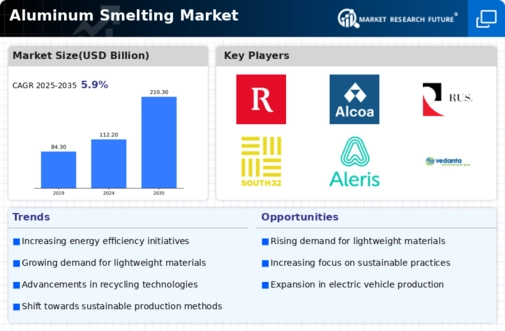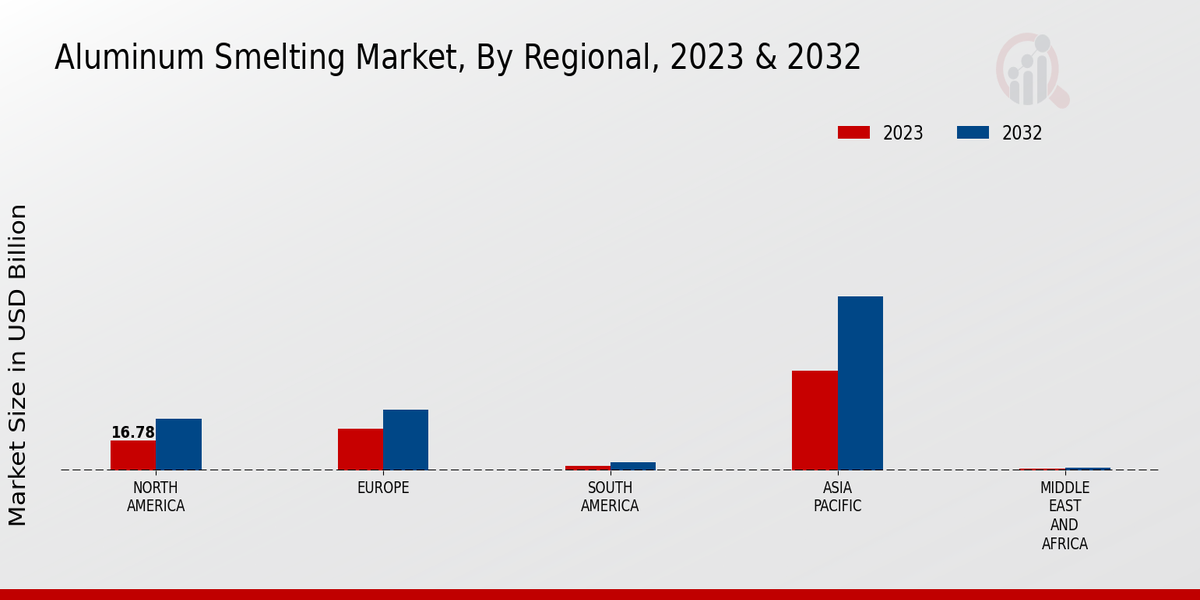Market Growth Projections
The Global Aluminum Smelting Market Industry is projected to experience substantial growth in the coming years, with a market value expected to reach 210.3 USD Billion by 2035. This growth is underpinned by various factors, including rising demand for aluminum in multiple sectors, technological advancements, and sustainability initiatives. The compound annual growth rate of 5.88% from 2025 to 2035 indicates a robust expansion trajectory, suggesting that the industry is well-positioned to capitalize on emerging opportunities. The interplay of these dynamics is likely to shape the future landscape of the Global Aluminum Smelting Market, making it a focal point for investors and stakeholders.
Growing Electric Vehicle Market
The burgeoning electric vehicle market is poised to significantly impact the Global Aluminum Smelting Market Industry. Aluminum is increasingly utilized in electric vehicles due to its lightweight nature, which enhances battery efficiency and overall vehicle performance. As governments worldwide implement stricter emissions regulations, the demand for electric vehicles is expected to rise, consequently increasing the need for aluminum. This trend is likely to contribute to the market's growth, with projections indicating a market value of 112.2 USD Billion in 2024. The synergy between the electric vehicle sector and aluminum smelting could potentially reshape the industry's landscape in the years to come.
Infrastructure Development Initiatives
Government-led infrastructure development initiatives across various regions are significantly bolstering the Global Aluminum Smelting Market Industry. Investments in transportation, energy, and urban development projects are driving the demand for aluminum, which is favored for its durability and corrosion resistance. For example, the construction of new railways and bridges necessitates substantial aluminum usage, contributing to the projected market growth. By 2035, the market is expected to reach 210.3 USD Billion, reflecting the critical role of infrastructure projects in sustaining aluminum demand. This trend suggests that as nations invest in infrastructure, the Global Aluminum Smelting Market will likely benefit substantially.
Rising Demand for Lightweight Materials
The Global Aluminum Smelting Market Industry is experiencing an upsurge in demand for lightweight materials, particularly in the automotive and aerospace sectors. As manufacturers strive to enhance fuel efficiency and reduce emissions, aluminum's lightweight properties make it an attractive alternative to traditional materials. This trend is reflected in the projected market value of 112.2 USD Billion in 2024, indicating a robust growth trajectory. The automotive industry, for instance, is increasingly incorporating aluminum components, which could potentially lead to a significant increase in aluminum consumption. This shift towards lightweight materials is likely to drive the Global Aluminum Smelting Market further in the coming years.
Sustainability and Recycling Initiatives
Sustainability and recycling initiatives are becoming central to the Global Aluminum Smelting Market Industry, as stakeholders increasingly prioritize environmentally friendly practices. The aluminum industry is known for its recyclability, with recycled aluminum requiring only a fraction of the energy needed for primary production. This focus on recycling not only conserves resources but also aligns with global sustainability goals. As consumers and industries demand greener solutions, the market is likely to see a shift towards more sustainable practices. This trend may contribute to the anticipated growth of the Global Aluminum Smelting Market, with projections indicating a market value of 210.3 USD Billion by 2035.
Technological Advancements in Smelting Processes
Technological advancements in aluminum smelting processes are enhancing efficiency and reducing environmental impact, thereby positively influencing the Global Aluminum Smelting Market Industry. Innovations such as the development of inert anode technology and improvements in energy efficiency are making smelting operations more sustainable. These advancements not only lower production costs but also align with global sustainability goals. As companies adopt these technologies, they may experience increased competitiveness in the market. The anticipated compound annual growth rate of 5.88% from 2025 to 2035 underscores the potential for growth driven by these technological improvements, positioning the Global Aluminum Smelting Market favorably for future expansion.























Leave a Comment